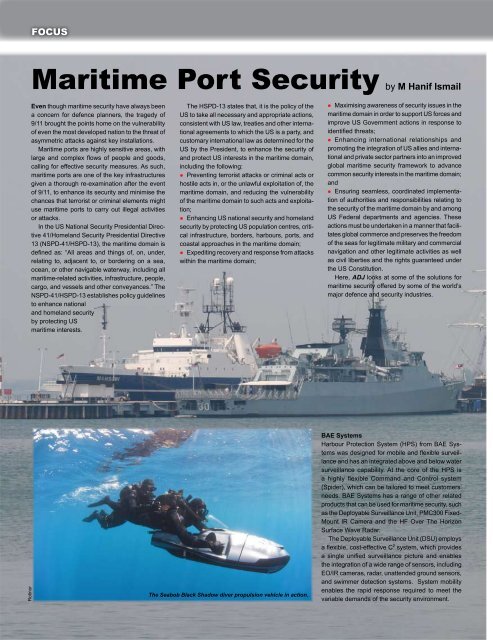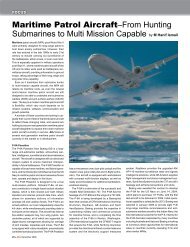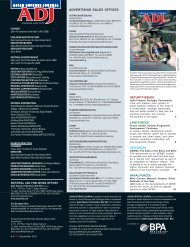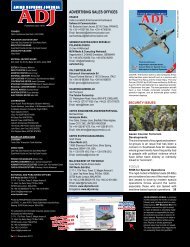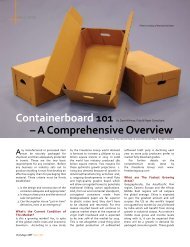Maritime Port Security by M Hanif Ismail
Maritime Port Security by M Hanif Ismail
Maritime Port Security by M Hanif Ismail
Create successful ePaper yourself
Turn your PDF publications into a flip-book with our unique Google optimized e-Paper software.
Rotinor<br />
FOCUS<br />
<strong>Maritime</strong> <strong>Port</strong> <strong>Security</strong> <strong>by</strong> M <strong>Hanif</strong> <strong>Ismail</strong><br />
Even though maritime security have always been<br />
a concern for defence planners, the tragedy of<br />
9/11 brought the points home on the vulnerability<br />
of even the most developed nation to the threat of<br />
asymmetric attacks against key installations.<br />
<strong>Maritime</strong> ports are highly sensitive areas, with<br />
large and complex flows of people and goods,<br />
calling for effective security measures. As such,<br />
maritime ports are one of the key infrastructures<br />
given a thorough re-examination after the event<br />
of 9/11, to enhance its security and minimise the<br />
chances that terrorist or criminal elements might<br />
use maritime ports to carry out illegal activities<br />
or attacks.<br />
In the US National <strong>Security</strong> Presidential Directive<br />
41/Homeland <strong>Security</strong> Presidential Directive<br />
13 (NSPD-41/HSPD-13), the maritime domain is<br />
defined as: “All areas and things of, on, under,<br />
relating to, adjacent to, or bordering on a sea,<br />
ocean, or other navigable waterway, including all<br />
maritime-related activities, infrastructure, people,<br />
cargo, and vessels and other conveyances.” The<br />
NSPD-41/HSPD-13 establishes policy guidelines<br />
to enhance national<br />
and homeland security<br />
<strong>by</strong> protecting US<br />
maritime interests.<br />
22 ADJ March 2010<br />
The HSPD-13 states that, it is the policy of the<br />
US to take all necessary and appropriate actions,<br />
consistent with US law, treaties and other international<br />
agreements to which the US is a party, and<br />
customary international law as determined for the<br />
US <strong>by</strong> the President, to enhance the security of<br />
and protect US interests in the maritime domain,<br />
including the following:<br />
Preventing terrorist attacks or criminal acts or<br />
hostile acts in, or the unlawful exploitation of, the<br />
maritime domain, and reducing the vulnerability<br />
of the maritime domain to such acts and exploitation;<br />
Enhancing US national security and homeland<br />
security <strong>by</strong> protecting US population centres, critical<br />
infrastructure, borders, harbours, ports, and<br />
coastal approaches in the maritime domain;<br />
Expediting recovery and response from attacks<br />
within the maritime domain;<br />
The Seabob Black Shadow diver propulsion vehicle in action.<br />
Maximising awareness of security issues in the<br />
maritime domain in order to support US forces and<br />
improve US Government actions in response to<br />
identified threats;<br />
Enhancing international relationships and<br />
promoting the integration of US allies and international<br />
and private sector partners into an improved<br />
global maritime security framework to advance<br />
common security interests in the maritime domain;<br />
and<br />
Ensuring seamless, coordinated implementation<br />
of authorities and responsibilities relating to<br />
the security of the maritime domain <strong>by</strong> and among<br />
US Federal departments and agencies. These<br />
actions must be undertaken in a manner that facilitates<br />
global commerce and preserves the freedom<br />
of the seas for legitimate military and commercial<br />
navigation and other legitimate activities as well<br />
as civil liberties and the rights guaranteed under<br />
the US Constitution.<br />
Here, ADJ looks at some of the solutions for<br />
maritime security offered <strong>by</strong> some of the world’s<br />
major defence and security industries.<br />
BAE Systems<br />
Harbour Protection System (HPS) from BAE Systems<br />
was designed for mobile and flexible surveillance<br />
and has an integrated above and below water<br />
surveillance capability. At the core of the HPS is<br />
a highly flexible Command and Control system<br />
(Spider), which can be tailored to meet customers’<br />
needs. BAE Systems has a range of other related<br />
products that can be used for maritime security, such<br />
as the Deployable Surveillance Unit, PMC300 Fixed-<br />
Mount IR Camera and the HF Over The Horizon<br />
Surface Wave Radar.<br />
The Deployable Surveillance Unit (DSU) employs<br />
a flexible, cost-effective C 2 system, which provides<br />
a single unified surveillance picture and enables<br />
the integration of a wide range of sensors, including<br />
EO/IR cameras, radar, unattended ground sensors,<br />
and swimmer detection systems. System mobility<br />
enables the rapid response required to meet the<br />
variable demands of the security environment.
ATLAS Elektronik<br />
The PMC300 uncooled infrared camera<br />
generates high-resolution thermal imagery that<br />
meets mission detection requirements at standoff<br />
distances that were once limited to cooled IR<br />
cameras. The PMC300 camera, based on BAE<br />
Systems’ advanced 640 x 480 MicroIR technology,<br />
provides long-range surveillance and vision<br />
enhancement. The PMC300 camera is also based<br />
on an environmentally qualified, modular design<br />
that allows users to tailor the unit to meet missionspecific<br />
performance requirements and rapidly<br />
deploy it in the harshest operational environments.<br />
A critical component of the camera’s design is BAE<br />
Systems’ family of interchangeable, single and<br />
dual field-of-view optics that can be configured<br />
to meet specific short-, medium-, and long-range<br />
imaging requirements. This configuration flexibility<br />
meets today’s application requirements and is<br />
unmatched <strong>by</strong> other uncooled infrared cameras.<br />
The High-Frequency Surface Wave Radar<br />
(HFSWR) offers low-cost performance over-thehorizon<br />
surveillance capability with flexible deployment<br />
to provide long-range early warning against<br />
surface vessels and low-flying aircraft.<br />
The Seawolf UUV.<br />
MARITIME PORT SECURITY<br />
This screen combines a Defender II with electronic chart display (ECD) and satellite photo overlay of the<br />
Vancouver harbour, downtown waterfront and Burrard Inlet around the Canada Place cruise ship docking<br />
facility and trade and convention centre. The red line tracks the movement of a diver towards a high value<br />
asset ship docked at the facility.<br />
The Double Eagle Mk III ROV.<br />
Kongsberg<br />
Saab<br />
ADJ March 2010 23
FOCUS<br />
Boeing<br />
Global <strong>Maritime</strong> <strong>Security</strong> (GMS) is a unit under<br />
Boeing Defense, Space and <strong>Security</strong>. GMS<br />
focuses Boeing-wide knowledge and key relationships<br />
into one unit dedicated to applying<br />
intelligence and security solutions to the specialised<br />
operations of ports, coastal and maritime<br />
environs and widely varied users. Through<br />
<strong>Maritime</strong> Domain Awareness, GMS provides<br />
solutions to protect the global maritime interests<br />
of the United States and friendly nations <strong>by</strong> using<br />
the information-sharing environment combined<br />
with multi-level security capabilities. As one of<br />
the top five US maritime cargo importers, to<br />
support aircraft manufacturing, Boeing is itself<br />
a stakeholder with vested interest in maritime<br />
supply-chain security and the safe and efficient<br />
flow of commerce. This gives Intelligence and<br />
<strong>Security</strong> Systems both the ability to bring technical<br />
expertise and tools to maritime security, and<br />
the insight to the impacts and effectiveness of<br />
technology applications.<br />
EADS NV<br />
EADS solutions for maritime security are divided<br />
into three; surveillance means, command and<br />
control system and intervention.<br />
For surveillance, EADS offers mobile platforms<br />
equipped with radar and camera (IR spectrum or<br />
TV): planes and UAVs for long-range surveillance<br />
missions of large areas; helicopters for area surveillance,<br />
object location and identification; ships<br />
or vessels for short-range surveillance. EADS can<br />
also equip coastal sites with radar, electro-optic<br />
and underwater sensors as well as Automatic<br />
Identification System (AIS). Intelligence means<br />
covers Intelligence, Surveillance and Reconnaissance<br />
System; observation satellite, real-time<br />
image analysis, sonar, risk assessment.<br />
24 ADJ March 2010<br />
The Vessel Traffic Management Systems (VTMS) provides effective coastal surveillance through radar<br />
detection and tracking of targets over coastal and territorial waters.<br />
For command and control system, EADS<br />
offers solutions for situational awareness<br />
(Common Operational Picture), resource<br />
management, location and dispatching, mission<br />
planning, decision support system, Vessel<br />
Traffic Services (VTS), communication means<br />
and data links.<br />
For intervention, EADS offers mobile platforms<br />
to track, intercept and perform interventions at<br />
sea.<br />
Part of the equation should also include security<br />
patrols well equipped with secure communications<br />
to the command.<br />
Finmeccanica<br />
Finmeccanica, the Italian leader in aerospace, defence<br />
and security offers the most comprehensive<br />
approach to homeland security, providing leading<br />
edge solutions based on its unrivalled multi-area<br />
technological background.<br />
Leveraging the technological and industrial<br />
base of its companies, Finmeccanica offers its<br />
customers capabilities and solutions that meet the<br />
strategic goal of global security; to prevent terrorists<br />
attacks, to reduce the vulnerability to terrorism<br />
of both population and key assets, and to minimise<br />
damage and recovery time after an attack.<br />
Finmeccanica systems have modular architectures<br />
that match different levels of requirements,<br />
with the capability to work standalone or within<br />
complex networks. The systems can fulfil single<br />
or broad security tasks, independently or within a<br />
state of the art architecture that expands into an integrated<br />
network-centric national security system.<br />
For security systems, flexibility is of paramount<br />
importance. Finmeccanica solutions provide the<br />
highest integration with existing assets, guaranteeing<br />
the required net-compatibility.<br />
Finmeccanica solutions for homeland security<br />
are organised around four pillars and rest upon a<br />
solid network-centric communications infrastructure<br />
that allows supervisory and coordination<br />
activity and distribution of services and information<br />
associated to the different levels.<br />
Having a long tradition in military integrated<br />
systems for patrolling and identification activities,<br />
allows Finmeccanica to offer its customers, stateof-the-art<br />
solutions for border surveillance, be it<br />
air, sea or land. The company expertise includes<br />
coastline and territorial water control, “Smart<br />
Border” air space surveillance, illegal immigration<br />
and checkpoints.<br />
Finmeccanica
Lockheed Martin<br />
Lockheed Martin is a leading designer and manufacturer<br />
of communications, command and control<br />
systems, radar, navigation/surveillance systems<br />
and other software-intensive products that are<br />
necessary for building fully integrated and fully<br />
networked systems.<br />
A prime example of one such networked system,<br />
the US Coast Guard’s Integrated Deepwater<br />
Program, leverages the company’s expertise in<br />
similar systems for the US Department of Defense<br />
customer. Likewise, the company is applying its<br />
multi-sensor technology through its Swimmer<br />
Intruder Detection System, which automatically<br />
detects, classifies and tracks all types of swimmer<br />
intruders.<br />
With Lockheed Martin’s legacy systems, such<br />
as the P-3 Airborne Early Warning and Control Aircraft<br />
and Tethered Aerostat Surveillance Systems,<br />
the company delivers systems that can monitor<br />
land and sea borders from the high ground. Tethered<br />
Aerostats provide continuous real-time radar<br />
surveillance and defence across the US southern<br />
border for both air and surface threats. Under<br />
contract from the US Missile Defense Agency,<br />
Lockheed Martin is building a prototype of the High<br />
Altitude Airship, a lighter-than-air vehicle that can<br />
be deployed at 60,000 feet.<br />
Lockheed Martin is taking a leading role in applying<br />
the cutting-edge technologies of biometrics<br />
and fingerprint identification to the challenges of<br />
homeland security. Lockheed Martin leveraged<br />
advanced technologies to create the capabilities<br />
for identifying and matching fingerprints in just<br />
hours instead of days or weeks. Lockheed Martin<br />
is involved in programmes that apply fingerprint<br />
technology and optical scanning to other biometric<br />
markers, providing highly secure credentialing and<br />
communications, as well as an unprecedented<br />
degree of interoperability among biometric scanning,<br />
matching and card subsystems.<br />
Raytheon<br />
Project Athena Multi-Domain Awareness System<br />
from Raytheon is a network centric, multi-domain<br />
command, control, communications, computers,<br />
intelligence, surveillance and reconnaissance<br />
(C 4 ISR) system for high performance situational<br />
awareness, fusion, analysis and knowledge<br />
management. By exploiting information from<br />
global sources—including sensors, databases<br />
and intelligence—Athena delivers persistent<br />
surveillance, situational awareness and anomaly<br />
detection aids to reduce operator workload.<br />
Athena uses a modern, extendable and open<br />
C 4 ISR framework that works with a wide range<br />
of sensors and collaborates across command<br />
centres and enterprise systems. It employs userfriendly<br />
and role-based methods of managing<br />
correlated information and sharing across local,<br />
regional or global joint command interests. Athena<br />
delivers fast and flexible multi domain awareness<br />
for rapid operational deployments using proven<br />
components.<br />
Athena is based on a proven systems architecture<br />
used <strong>by</strong> NORAD. This robust system can<br />
process multiple inputs on many thousands of<br />
tracks. With a look and feel common to existing<br />
command and control centres, Athena is also userfriendly.<br />
Athena’s framework is based on a tiered,<br />
service-oriented architecture, uses off-the-shelf<br />
components and conforms to US Department of<br />
Defense architecture framework standards. Athena<br />
adds value <strong>by</strong> providing rules-based anomaly<br />
analysis and software agent capabilities, along<br />
with network centric service capabilities.<br />
Raytheon operates the Project Athena Multi-<br />
Domain Awareness Testbed at its facility in<br />
<strong>Port</strong>smouth, Rhode Island. Here, Raytheon<br />
provides ongoing demonstrations of Athena’s<br />
multi-domain capabilities, using live feeds and<br />
simulated threat scenarios, real-time display and<br />
analysis, and real-time re-planning for multiple<br />
event assessments.<br />
Scenarios include global domain awareness<br />
across operational commands; surveillance<br />
across domains (land, air, sea); evaluation of<br />
operational concepts and technology; and border<br />
threats and interdiction. Operational deployments<br />
for border surveillance missions have demonstrated<br />
a robust, user-friendly and effective field<br />
C 4 ISR capability.<br />
Representatives from Raytheon Integrated<br />
Defense Systems joined local, state and federal<br />
officials in Providence, on Apr 16, 2009, for a<br />
demonstration of the <strong>Port</strong> Area Waterside Surveillance<br />
System, or PAWSS. The demonstration<br />
took place at the grand opening of the Providence<br />
Emergency Management Agency’s new<br />
Emergency Operations Centre (EOC). Raytheon<br />
permanently deployed the sensors and its Athena<br />
data fusion and operations centre technology to<br />
provide situational awareness capability. With a<br />
network of sensors from the southern entrance<br />
of Narragansett Bay to the <strong>Port</strong> of Providence 25<br />
miles north, PAWSS allows decision makers to<br />
MARITIME PORT SECURITY<br />
spot and evaluate threats early. Athena integrates<br />
information from the sensors, including radars and<br />
day vision cameras, to provide input to the Rhode<br />
Island Common Operating Picture (RICOP). This<br />
gives officials advance warning and the improved<br />
situational awareness needed to maintain port<br />
security. The shared future vision of RICOP is to<br />
provide an integrated and enhanced situational<br />
awareness capability that provides statewide public<br />
safety and security across multiple domains.<br />
Athena would serve as the data fusion and decision<br />
support backbone.<br />
Thales<br />
The new<br />
Coast<br />
Watcher<br />
radar range<br />
ensures the<br />
safety and<br />
security from<br />
surveillance<br />
of territorial<br />
waters to site<br />
protection<br />
and early<br />
warning<br />
detection of<br />
surface and<br />
air threats.<br />
Thales<br />
Thales provides end-to-end integrated security<br />
solutions to secure port facilities in compliance<br />
with the International Ship and <strong>Port</strong> <strong>Security</strong><br />
(ISPS) Code adopted <strong>by</strong> the International <strong>Maritime</strong><br />
Organisation (IMO).<br />
Thales has the ability to manage, integrate<br />
and provide long-term support for innovative<br />
solutions to meet security requirements for port<br />
infrastructures: terminals, marinas, loading areas<br />
and administrative buildings.<br />
Thales port security solutions are part of<br />
Thales SHIELD, the brand name of the whole<br />
Thales group security and safety portfolio.<br />
They incorporate the most recent technological<br />
advances in access control integration, digital<br />
video surveillance, perimeter detection, tracking,<br />
supervision and security operations management.<br />
The systems are adapted to coastal environment,<br />
calling for corrosion-proof materials and<br />
optimised installation to minimise the effects of<br />
adverse weather conditions. Thales also delivers<br />
consulting services to cover all aspects of security<br />
risk management, whether IT-related, physical,<br />
environmental or people-oriented.<br />
Customer references in this field include comprehensive<br />
security solutions for the port of Calais,<br />
one of Europe’s biggest seaports and global<br />
supervision of the autonomous port of Nantes<br />
Saint-Nazaire on the Atlantic coast.n<br />
ADJ March 2010 25


